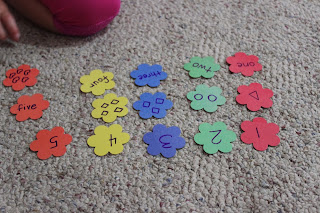Materials: tangram puzzles OR printable tangram pieces and templates found here:
Print off pieces and puzzles here:
Tangram Pieces
Use clipart to create puzzles here:
Tangram Clipart
More puzzles to print:
Tangram Puzzles
Talk about the names and characteristics of each shape (# sides, one side is longer, equal lengths, etc.)
 |
| Melissa and Doug Tangram Puzzles |
 |
| Very simple matching of shapes to the outline. |
 |
| N tried to fit different pieces together to make them fit. |
Kansas Early Learning Standards
By 36 months
M.G.t.3:
Manipulates shapes to place in a form board or simple puzzle.
By 48 months
M.G.p3.2:
Correctly names shapes regardless of their orientations or overall size.
M.G.p3.3:
Analyzes and compares shapes in different sizes and orientations and uses informal
language to describe their similarities, difference and part (e.g.,number of sides and corners) and other attributes (e.g., having sides of equal length)
M.MD.p3.2:
Sorts objects into two or more groups by their properties or uses (e.g., sorts blocks into 2 piles; sorts by shape)
M.CC.p3.6:
Identifies whether the number of objects in one group is more or less as compared to the number of objects in another group up to 5
By 60 months
M.MD.p4.3:
Sorts objects into categories; counts the numbers of objects in each category (limit category counts to less than or equal to 10); makes comparisons between the categories based on quantity.
M.MD.p4.2:
Directly compares two objects with a measurable attribute in common to see which objects has “more of ”/ “less of ” the attribute.
Extended Activities using Tangrams:
1) Sort the pieces by colors
2) Sort the pieces by shapes
3) Count how many in each category
4) Talk about which category has more or less (ex. Are there more blue than white?, Which color/shape has the fewest?)
5) Use the mathematical terms for the shapes (ex. rhombus instead of diamond, trapezoid, hexagon)
 |
| N sorting by colors and counting how many in each group. |
6) Let your child come up with their own creation using the tangram pieces.
 |
| N discovered that the hexagons fit together. |
Have fun watching your child discover the world of tangrams!








